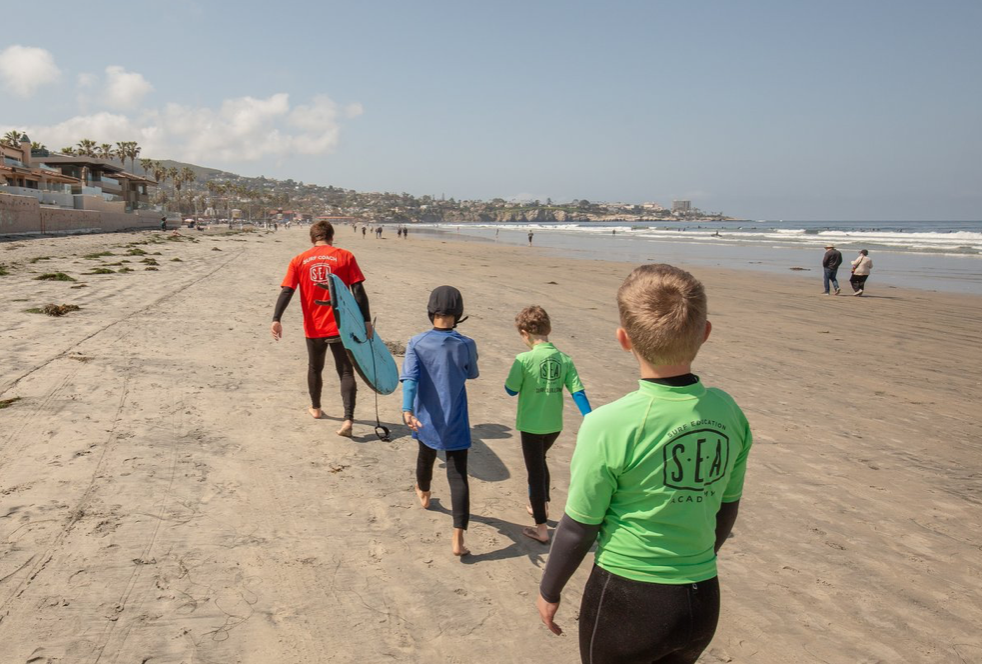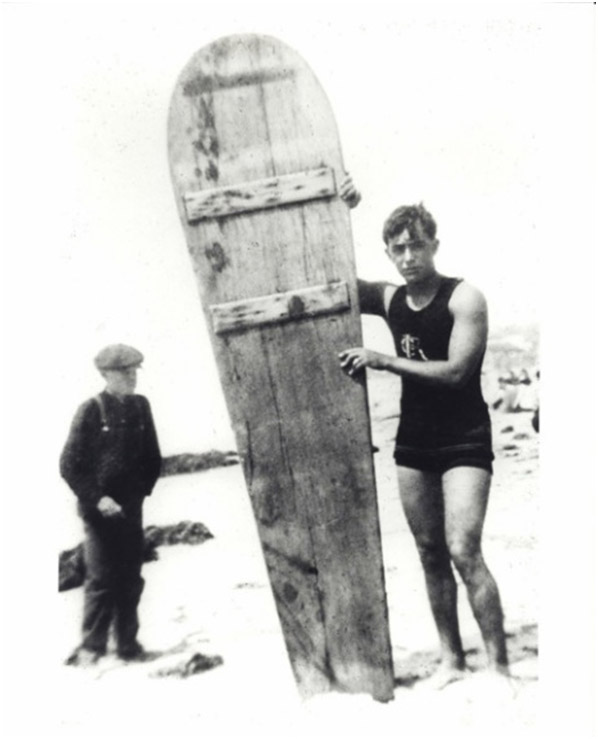
Walk down Avenida de la Playa just after sunrise and you’ll hear it—the rhythmic crash of waves, the scrape of longboards on the pavement, the easy banter between locals in wetsuits. La Jolla Shores isn’t just a beautiful stretch of San Diego coastline—it’s a living chapter in California’s surfing story. From Hawaiian pioneers introducing wave-riding to the mainland, to the golden days of the 1960s surf boom, to today’s thriving camps and community events, the Shores has shaped—and been shaped by—the people who ride here.
Whether you’re visiting for the first time, you grew up here, or you’re about to take your first lesson, this beach’s story is part of your own journey.
The Early Days of Surfing in La Jolla Shores
Surfing arrived in California in the early 1900s, carried by the stoke and skill of Hawaiian watermen like George Freeth. Often called the “Father of Modern Surfing,” Freeth wowed crowds up and down the coast with his demonstrations, planting the seeds for what would become a full-fledged West Coast surf culture. His influence is so lasting that his legacy is honored in places like the California Surf Museum.
While Redondo Beach and Huntington Beach saw some of the first California surfers, La Jolla Shores soon became part of the movement. Its sandy bottom, consistent waves, and protected cove created a perfect environment for early boards—which were long, heavy redwood planks weighing 80 to 100 pounds.
By the 1930s, a dedicated crew of locals was paddling out here regularly. These early surfers didn’t just ride waves—they built a community that valued ocean respect, camaraderie, and passing knowledge to the next generation.

The Shores in the Golden Age of Surfing
The 1950s and 60s marked a turning point. Post-war optimism was in the air, and surfboard design was evolving rapidly—wood gave way to foam-and-fiberglass, allowing for faster, more maneuverable rides. Films like The Endless Summer and music from The Beach Boys put surfing into the cultural spotlight, and La Jolla Shores was right in the thick of it.
During this era, local surf clubs emerged, homegrown surf films were passed around on reels at community gatherings, and amateur contests drew big crowds. La Jolla High School’s surf scene was a pipeline for some of San Diego’s future legends.
What made the Shores special was its balance: gentle, forgiving waves for beginners and just a short paddle away, more challenging breaks like Scripps and Black’s Beach for advanced surfers. Many locals still say, “The Shores is where you learn to surf—and where you learn to love the ocean.”
What Makes La Jolla Shores Unique for Surfers
- Beginner-Friendly Break – The gradual slope and sandy bottom create long, soft waves perfect for learning and longboarding.
- Proximity to Advanced Spots – Paddle north for more challenging rides at Scripps Pier or, if you’re ready, make the trek to Black’s Beach for world-class barrels.
- Tight-Knit Lineup Culture – Respect in the water is everything here. Don’t snake a grom, always nod when someone’s charging a set, and you’ll quickly feel at home.
- Marine Protected Setting – Being part of the La Jolla Ecological Reserve means clean water, abundant marine life, and a daily reminder of the ocean’s value.
Surf Education Academy’s Role in the Story
At Surf Education Academy, we see ourselves as more than instructors—we’re part of the Shores’ living history. Our roots are here, our coaches grew up here, and our lessons are built around the rhythms of this specific break.
We’re not just teaching pop-ups and turns—we’re passing on the “why” behind surfing:
- Local wave knowledge so students learn when and where to paddle out based on tides, swell direction, and seasonal shifts.
- Ocean safety training covering rip currents, reef awareness, and surf etiquette—because knowing the ocean is as important as riding it.
- Community connection through surf camps, school partnerships, and family surf days where everyone shares the stoke.
Many of our instructors started as kids in SEA’s programs and are now mentoring the next generation—keeping the cycle of local surf knowledge alive. You can explore more in our other blogs.
Giving Back: Conservation and Community
Surf history means nothing without a healthy ocean to surf in. That’s why SEA is committed to protecting the coastline we call home. We support:
- Youth scholarships for underserved kids so every child has the chance to experience the joy of surfing.
- Monthly beach cleanups in partnership with local groups.
- Conservation days focused on the unique marine environment of the La Jolla Ecological Reserve.
Our belief is simple: the more you love the ocean, the more you’ll fight to protect it.
Local Insight: The Culture of the Shores
Ask a La Jolla surfer about their first wave and you’ll likely get a detailed play-by-play, right down to the smell of neoprene and the taste of saltwater. This beach breeds memories that stick. Dawn patrol sessions with just a few friends, summer afternoons filled with surf camps, and winter swells that light up Scripps—it’s all part of the rhythm here.
FAQs About Surfing History at La Jolla Shores
Was surfing invented here?
No. Surfing originated in Polynesia and Hawaii, but La Jolla Shores became one of California’s most important surf communities in the 20th century.
Who are some of the local legends?
Skip Frye, the Ekstrom brothers, and countless homegrown talents who came up through local schools and competitions have helped shape San Diego’s reputation in the surf world.
Is it beginner-friendly year-round?
Yes—though winter swells can be bigger, the beach break remains forgiving compared to more exposed spots.
How can I get involved in the community?
Join a beach cleanup, sign up for a lesson, or simply paddle out and share the stoke. Every respectful surfer becomes part of the Shores’ ongoing story.
Ready to Ride?
The history of La Jolla Shores is still being written—wave by wave. Whether you’re catching your first whitewater ride or trimming down the line at sunrise, you’re part of a tradition over a century in the making.
Join us at Surf Education Academy, where every wave is more than a ride—it’s a connection to the ocean, the past, and your own personal surf journey. You can book your surf lesson today and be part of the next chapter in this iconic beach’s history.


 The Science Behind Waves and Their Importance to Our Ecosystem
The Science Behind Waves and Their Importance to Our Ecosystem